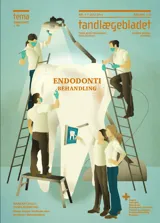Kronebehandling af den endodontisk behandlede tand
Endodontisk behandlede tænder mangler ofte tandsubstans. Rodstift og opbygning bruges derfor hyppigt ved endodontisk behandlede tænder for at forøge retentionen af en fyldning, krone eller bro. Endodontisk behandlede tænder med rodstift har generelt set bedre prognose, når de er restaureret med en krone end med en fyldning. Præparation til en rodstift svækker tanden, og en tand skal derfor kun forsynes med en rodstift, når der er et behov for øget retention. En præfabrikeret stift med parallelle sider giver den bedste retention og sikkert også den bedste prognose for tanden. Den væsentligste faktor for at forbedre prognosen for en tand med rodstift er dog at anvende en omsluttende præparation, så kronen kan medføre en tøndebåndseffekt.
Crown restoration on the endodontically treated tooth: Endodontically treated teeth often lack sufficient tooth structure. Therefore, a post and core are often used to increase the retention of a filling, crown or fixed prosthesis. Endodontically treated teeth with a post and core generally have a better prognosis when they are restored with a crown than with a filling. Root canal preparation for a post weakens the tooth. Therefore, a post and core should only be used when there is a need to increase the retention. A prefabricated post with parallel sides gives the best retention and probably the best prognosis for the tooth. The main factor for improving the prognosis of a tooth with post and core is to make use of the ferrule effect of a crown.


